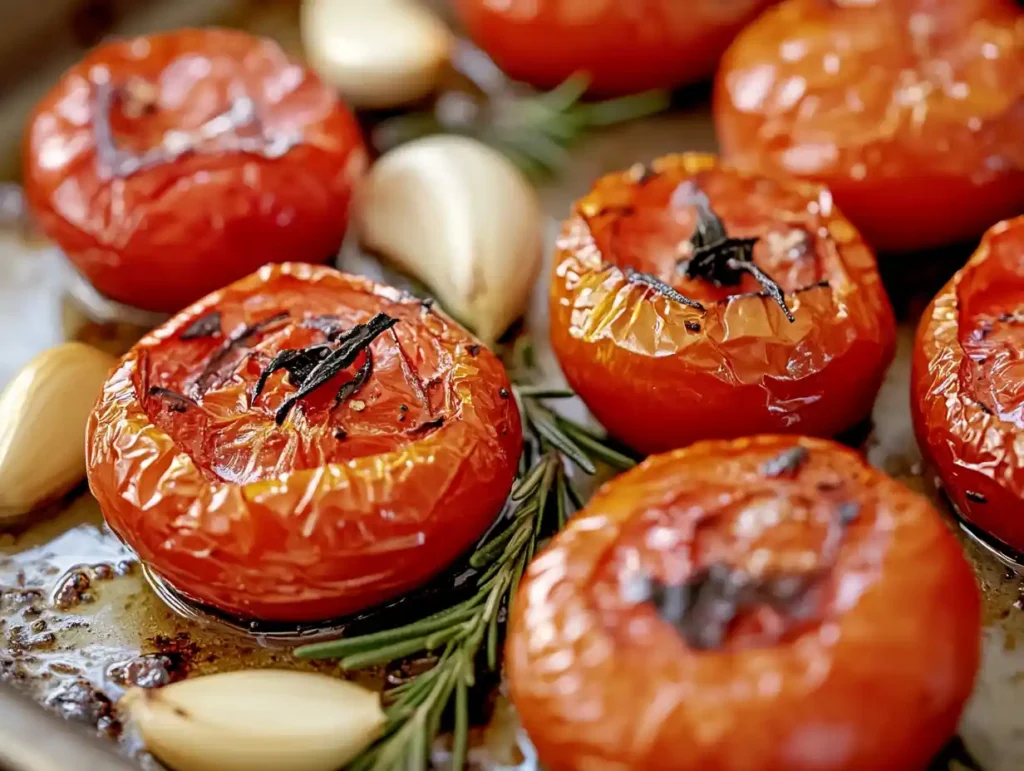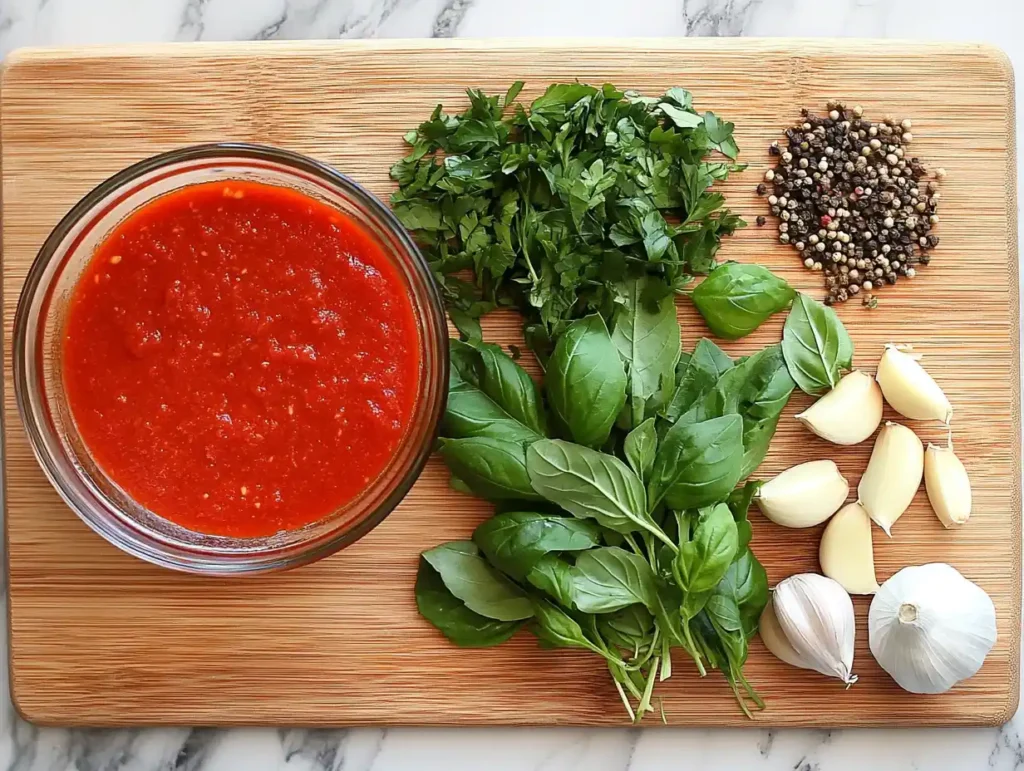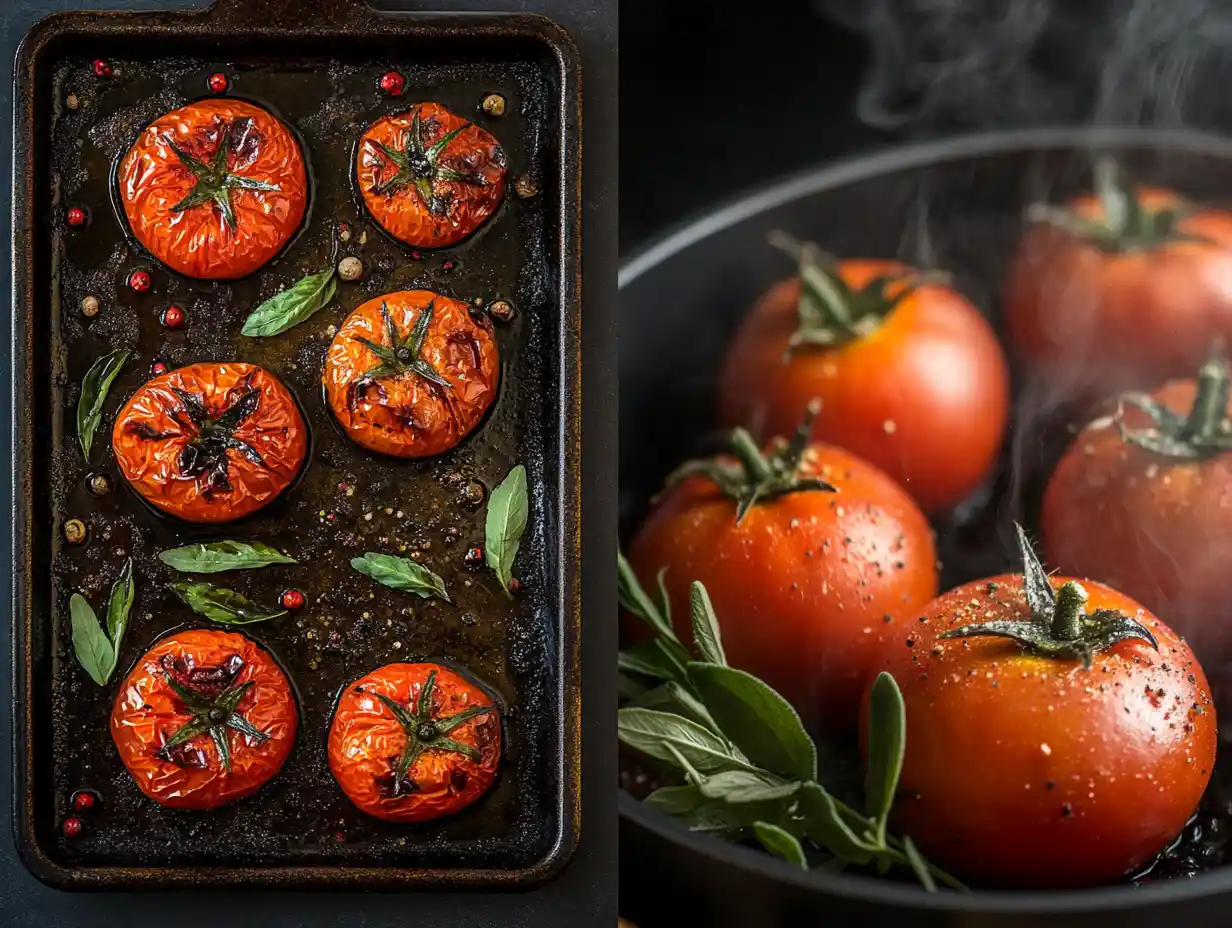Tomato sauce is a key ingredient in many popular dishes. From Italian pasta to hearty stews, it adds flavor and depth. But there’s a common question among home cooks: should you roast or boil tomatoes for sauce?
Each method offers unique benefits. Roasting intensifies flavors, while boiling is a classic approach for a fresh taste. Both techniques affect the sauce’s flavor, texture, and nutrition differently.
In this article, we’ll explore both methods. You’ll learn how each impacts your sauce and which works best for your recipe. By the end, you’ll have all the tips you need to make the perfect tomato sauce!
Understanding the Basics of Tomato Sauce
The Role of Tomatoes in Sauce Making
Tomatoes are the soul of any good tomato sauce. Their natural acidity, sweetness, and umami flavors provide a perfect base for many cuisines. The cooking process breaks down the fruit’s structure, releasing juices and softening the flesh. This transformation helps achieve the desired consistency for the sauce.
Both roasting and boiling highlight different qualities of tomatoes. While roasting enhances the sweetness and adds a smoky touch, boiling keeps the taste lighter and fresher. Understanding the role tomatoes play will help you decide which method suits your sauce.
Key Components of a Perfect Tomato Sauce
A good tomato sauce is all about balance. The key components include:
- Acidity: Adds brightness and prevents the sauce from feeling too heavy.
- Sweetness: Naturally present in tomatoes, this balances the acidity. Adding a pinch of sugar can help if needed.
- Thickness: A thicker consistency is ideal for pasta sauces, while thinner sauces work better for soups or stews.
- Flavor Layers: Herbs, spices, and aromatics like garlic or onion enhance the base tomato flavor.
Both preparation methods—roasting and boiling—contribute to these elements differently.
Fresh vs. Canned Tomatoes: A Quick Comparison
When deciding whether to roast or boil, consider the type of tomatoes you’re using. Fresh tomatoes are versatile but require peeling and deseeding for a smooth sauce. On the other hand, canned tomatoes are prepped and ready to use.
- Fresh Tomatoes: Best for a bright and fresh sauce. They are ideal for boiling but can also be roasted for added flavor.
- Canned Tomatoes: Convenient and consistent in taste. Roasting can deepen their flavor, while boiling works well for quick sauces.
Your choice of fresh or canned tomatoes can influence whether roasting or boiling works best.
Roasting Tomatoes for Sauce

Why Roast Tomatoes?
Roasting tomatoes caramelizes their natural sugars, resulting in a rich and concentrated flavor. The process brings out a smoky sweetness that adds depth to any sauce. Roasting also reduces the water content, making the sauce thicker and more robust.
This method is perfect for recipes that need bold flavors, like pasta sauces or pizza bases. It’s especially useful if you’re working with tomatoes that are slightly underripe or lack sweetness.
Benefits of Roasting Tomatoes for Sauce
Roasting offers several advantages:
- Flavor: The high heat enhances natural sweetness and umami.
- Thicker Sauce: Roasting evaporates water, creating a more concentrated base.
- Customizable: Adding garlic, onions, or herbs to the roasting pan creates additional layers of flavor.
While roasting takes longer than boiling, the results are worth the extra effort for many dishes.
Techniques for Roasting Tomatoes
To roast tomatoes:
- Preheat your oven to 400°F (200°C).
- Slice tomatoes in half and place them cut-side up on a baking sheet.
- Drizzle with olive oil and sprinkle with salt and pepper.
- Add optional aromatics like garlic cloves or rosemary.
- Roast for 25–35 minutes, depending on the size of the tomatoes.
Once roasted, let the tomatoes cool slightly before peeling off the skins. Blend them into a sauce or mash them for a chunkier texture.
Ideal Tomato Varieties for Roasting
Not all tomatoes roast equally well. For best results, choose varieties with a firm texture and rich flavor:
- Roma (Plum) Tomatoes: Their meaty flesh and low water content make them ideal for roasting.
- Cherry Tomatoes: Perfect for quick roasting. They become incredibly sweet and caramelized.
- Heirloom Tomatoes: These add complexity but may need longer roasting due to their size.
Selecting the right tomato variety ensures your roasted sauce will turn out delicious.
Boiling Tomatoes for Sauce
Why Boil Tomatoes?
Boiling is one of the oldest and simplest methods for preparing tomatoes for sauce. It is especially effective for making traditional, fresh-tasting sauces. Boiling softens the tomatoes, making them easy to peel, deseed, and puree.
This method retains the natural brightness of tomatoes, offering a lighter flavor compared to roasting. Boiling is also quicker and more suitable for large batches, making it ideal for family meals or canning purposes.
Benefits of Boiling Tomatoes for Sauce
Boiling tomatoes offers several advantages:
- Quick Preparation: Softens the tomatoes rapidly for easy processing.
- Lighter Flavor: Maintains the fresh and tangy taste of tomatoes.
- Preserves Juiciness: Retains more liquid, ideal for thinner sauces like marinara.
- Time-Efficient: A faster method, especially for peeling and seeding tomatoes.
While boiling doesn’t develop the same deep flavors as roasting, it’s perfect for dishes where a fresher profile is desired.
Techniques for Boiling Tomatoes
To boil tomatoes for sauce:
- Fill a large pot with water and bring it to a rolling boil.
- Score the bottom of each tomato with a small “X” to make peeling easier.
- Place the tomatoes in the boiling water for 30–60 seconds, or until the skins begin to loosen.
- Immediately transfer the tomatoes to an ice water bath to cool.
- Peel off the skins, cut out the cores, and remove seeds if desired.
After boiling, blend the tomatoes for a smooth sauce or mash them with a fork for a chunkier texture.
Ideal Tomato Varieties for Boiling
Certain tomatoes work better for boiling due to their juiciness and balance of acidity:
- Roma (Plum) Tomatoes: Their consistency and flavor make them versatile for boiling.
- San Marzano Tomatoes: Known for their sweetness and low acidity, these are a favorite for classic Italian sauces.
- Beefsteak Tomatoes: Their juiciness works well for thinner sauces or soups.
Choosing the right variety ensures your boiled sauce has the right balance of flavor and texture.
Roasting vs. Boiling: Which Method Wins?
Comparing Flavor Profiles: Roasted vs. Boiled
The flavor difference between roasting and boiling tomatoes is one of the biggest factors in choosing a method:
- Roasted Tomatoes: Deep, smoky, and slightly sweet. The caramelization intensifies the natural flavors, making them perfect for bold, rich sauces.
- Boiled Tomatoes: Fresh, tangy, and bright. Boiling preserves the natural taste of the tomatoes, ideal for lighter and more traditional recipes.
Your choice depends on the type of sauce you’re aiming for. Roasting suits hearty dishes, while boiling works well for delicate flavors.
Texture and Consistency Differences
The cooking method also impacts the sauce’s texture:
- Roasted Tomatoes: Thick and concentrated due to reduced water content. Excellent for creamy or chunky sauces.
- Boiled Tomatoes: Juicier and thinner, with a smoother consistency when blended. Perfect for marinara or soup bases.
Consider the dish you’re making to decide which texture aligns best with your needs.
Nutritional Impact of Each Method
Both methods affect the nutritional profile of the sauce differently:
- Roasting: The high heat can destroy some vitamin C but increases the bioavailability of antioxidants like lycopene, which is beneficial for heart health.
- Boiling: Preserves more vitamin C but may result in a slightly less concentrated nutrient profile overall.
Both methods are healthy, so the choice comes down to your taste preference and cooking style.
Tips for the Best Tomato Sauce

Enhancing Flavor with Herbs and Spices
No tomato sauce is complete without the right seasonings. Fresh or dried herbs like basil, oregano, and thyme enhance both roasted and boiled sauces. Garlic, onion, and a splash of olive oil also elevate the flavor. Adding red pepper flakes can provide a subtle kick of heat.
Combining Roasting and Boiling for Depth
For a truly unique sauce, consider combining both methods:
- Roast a portion of your tomatoes to add richness and smoky flavor.
- Boil the rest to keep the sauce fresh and bright.
- Blend the two together to create a balanced and multi-dimensional sauce.
This hybrid approach gives you the best of both worlds.
Choosing the Right Cooking Tools
To make sauce preparation easier, invest in the right tools:
- A blender or food processor for smooth sauces.
- A sieve or food mill to remove seeds and skins.
- Heavy-bottomed pots for even cooking and reducing sauces without burning.
The right tools ensure a hassle-free cooking process and a high-quality result.
Frequently Asked Questions (FAQs)
How Do Roasting and Boiling Affect Acidity?
Both methods impact the acidity of your sauce differently. Roasting caramelizes the natural sugars in tomatoes, reducing perceived acidity and making the sauce taste sweeter. Boiling preserves the fresh, tangy flavor of the tomatoes, which can make the acidity more noticeable. If you prefer a balanced sauce, consider adding a pinch of sugar or a splash of cream to boiled sauces.
Can You Mix Roasted and Boiled Tomatoes?
Yes, combining roasted and boiled tomatoes can create a sauce with a rich and balanced flavor profile. Roasted tomatoes provide depth and sweetness, while boiled tomatoes add brightness and juiciness. This method is ideal for sauces where you want complexity without overpowering the dish.
Which Method Is Faster for Large Batches?
Boiling is generally faster and more efficient for processing large quantities of tomatoes. It softens the fruit quickly, making it easier to peel and seed. Roasting takes more time due to the slower cooking process and limited oven space, but it’s worth it for smaller, flavor-intensive batches.
Does Roasting or Boiling Waste More Nutrients?
Both methods cause some nutrient loss due to heat exposure, but the impact varies. Boiling retains more vitamin C since the cooking time is shorter. Roasting, on the other hand, enhances the bioavailability of lycopene, a powerful antioxidant. To maximize nutrients, avoid overcooking regardless of the method.
What’s the Best Method for Freezing Tomato Sauce?
Both roasted and boiled tomato sauces freeze well. However, sauces made from roasted tomatoes often have a more concentrated flavor, which holds up better after freezing. Be sure to store your sauce in airtight containers or freezer-safe bags to preserve freshness. Label and date the containers for easy reference.
Are Some Herbs Better for Roasted vs. Boiled Sauces?
Yes, some herbs pair better with certain methods. For roasted sauces, bold herbs like rosemary and thyme complement the smoky, rich flavor. For boiled sauces, lighter herbs like basil and parsley work well with the fresh and tangy profile. Adding herbs at the right time—early for dried and late for fresh—can enhance the overall taste.
Conclusion
Both roasting and boiling are excellent methods for preparing tomatoes for sauce, each with its own strengths. Roasting enhances sweetness and adds a smoky depth, making it ideal for hearty and rich sauces. Boiling, on the other hand, preserves the fresh and tangy taste of tomatoes, perfect for lighter dishes.
Your choice depends on your culinary goals. If you’re making a robust sauce for pizza or pasta, roasting may be your best bet. For a fresh marinara or soup base, boiling is the way to go. For those seeking a balanced and multi-layered flavor, combining both methods is a winning strategy.
Experiment with both techniques to find what works best for your recipes. Whether you roast, boil, or mix the two, the key is to let the natural flavor of tomatoes shine. With the tips and techniques in this guide, you’re sure to create a sauce that elevates any dish.
For more inspiration on enhancing your recipes, check out the best tomatoes for pasta sauce. Interested in roasted tomatoes? Don’t miss roasted tomatoes for pasta sauce. Plus, explore what makes sourdough garlic bread a perfect pairing.

